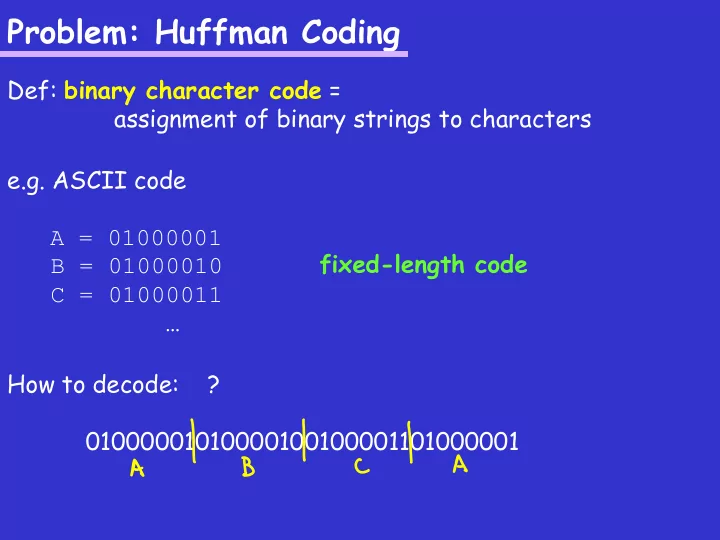

Problem: Huffman Coding Def: binary character code = assignment of binary strings to characters e.g. ASCII code A = 01000001 fixed-length code B = 01000010 C = 01000011 … How to decode: ? 01000001010000100100001101000001
Problem: Huffman Coding Def: binary character code = assignment of binary strings to characters e.g. code A = 0 variable-length code B = 10 C = 11 … How to decode: ? 0101001111
Problem: Huffman Coding Def: binary character code = assignment of binary strings to characters e.g. code A = 0 variable-length code B = 10 C = 11 Def: … A code is prefix-free if no How to decode: ? codeword is a prefix of another codeword. 0101001111
Problem: Huffman Coding Def: binary character code = assignment of binary strings to characters e.g. another code A = 1 variable-length code B = 10 C = 11 Def: … A code is prefix-free if no How to decode: ? codeword is a prefix of another codeword. 10101111
Problem: Huffman Coding Def: E 11.1607% M 3.0129% A 8.4966% H 3.0034% Huffman coding is an R 7.5809% G 2.4705% optimal prefix-free code. I 7.5448% B 2.0720% O 7.1635% F 1.8121% T 6.9509% Y 1.7779% N 6.6544% W 1.2899% S 5.7351% K 1.1016% L 5.4893% V 1.0074% C 4.5388% X 0.2902% U 3.6308% Z 0.2722% D 3.3844% J 0.1965% Optimization problems P 3.1671% Q 0.1962% - Input: - Output: - Objective:
Problem: Huffman Coding Def: E 11.1607% M 3.0129% A 8.4966% H 3.0034% Huffman coding is an R 7.5809% G 2.4705% optimal prefix-free code. I 7.5448% B 2.0720% O 7.1635% F 1.8121% T 6.9509% Y 1.7779% N 6.6544% W 1.2899% S 5.7351% K 1.1016% L 5.4893% V 1.0074% C 4.5388% X 0.2902% U 3.6308% Z 0.2722% D 3.3844% J 0.1965% Huffman coding P 3.1671% Q 0.1962% - Input: an alphabet with frequencies - Output: a prefix-free code - Objective: minimize expected number of bits per character
Problem: Huffman Coding Example: A 60% Is fixed-width coding optimal ? B 20% C 10% D 10% Huffman coding - Input: an alphabet with frequencies - Output: a prefix-free code - Objective: minimize expected number of bits per character
Problem: Huffman Coding Example: A 60% Is fixed-width coding optimal ? B 20% NO, exists a prefix-free code C 10% using 1.6 bits per character ! D 10% Huffman coding - Input: an alphabet with frequencies - Output: a prefix-free code - Objective: minimize expected number of bits per character
Problem: Huffman Coding Huffman ( [a 1 ,f 1 ],[a 2 ,f 2 ],…,[a n ,f n ]) 1. if n=1 then 2. code[a 1 ] “” 3. else 4. let f i ,f j be the 2 smallest f’s 5. Huffman ( [a i ,f i +f j ],[a 1 ,f 1 ],…,[a n ,f n ] ) omits a i ,a j 6. code[a j ] code[a i ] + “0” 7. code[a i ] code[a i ] + “1” Huffman coding - Input: an alphabet with frequencies - Output: a prefix-free code - Objective: minimize expected number of bits per character
Problem: Huffman Coding Lemma 1: Let x,y be the symbols with frequencies f x > f y . Then in an optimal prefix code length(C x ) length(C y ).
Problem: Huffman Coding Lemma 1: Let x,y be the symbols with frequencies f x > f y . Then in an optimal prefix code length(C x ) length(C y ). Lemma 2: If w is a longest codeword in an optimal code then there exists another codeword of the same length.
Problem: Huffman Coding Lemma 1: Let x,y be the symbols with frequencies f x > f y . Then in an optimal prefix code length(C x ) length(C y ). Lemma 2: If w is a longest codeword in an optimal code then there exists another codeword of the same length. Lemma 3: Let x,y be the symbols with the smallest frequencies. Then there exists an optimal prefix code such that the codewords for x and y differ only in the last bit.
Problem: Huffman Coding Lemma 1: Let x,y be the symbols with frequencies f x > f y . Then in an optimal prefix code length(C x ) length(C y ). Lemma 2: If w is a longest codeword in an optimal code then there exists another codeword of the same length. Lemma 3: Let x,y be the symbols with the smallest frequencies. Then there exists an optimal prefix code such that the codewords for x and y differ only in the last bit. Theorem: The prefix code output by the Huffman algorithm is optimal.
Recommend
More recommend